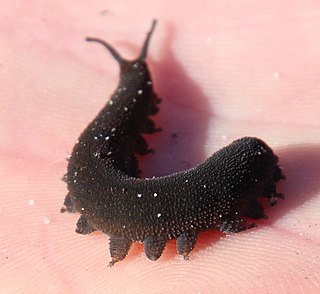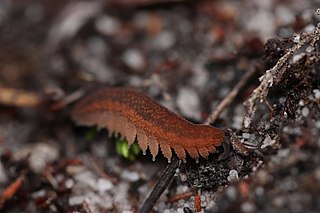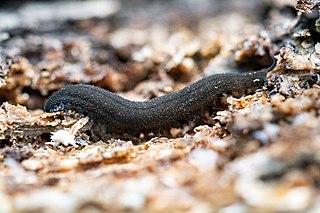Opisthopatus roseus is a species of velvet worm in the Peripatopsidae family. As traditionally defined, this species is rose pink with 18 pairs of legs. Known as the pink velvet worm, it is found only in the Weza Forest, a Mistbelt Forest in South Africa. Specimens have been found on the forest floor amongst leaf litter, beneath, and within fallen logs.
Peripatoides suteri is a species of velvet worm in the Peripatopsidae family. This species is ovoviviparous, has 16 pairs of legs, and is endemic to New Zealand. These velvet worms range in size from 14 mm to 90 mm.

Peripatopsidae is one of the two living velvet worm families.
Metaperipatus is a genus of velvet worms in the family Peripatopsidae that includes the species Metaperipatus inae. Males of this species have 20 pairs of legs; females have 22 pairs. This species is a dark grayish blue in color, with large orange/red spots. When walking, females of this species can be as long as 85 mm, and males can be as long as 60 mm. The type locality is in central Chile.
Paraperipatus is a genus of velvet worms in the family Peripatopsidae. The number of legs vary within species as well as among species in this genus and can range from as few as 21 pairs up to 27 pairs in males and 29 pairs in females. The maximum number of leg pairs recorded in this genus (29) is also the maximum number of leg pairs found in the family Peripatopsidae. This genus exhibits matrotrophic viviparity, that is, mothers in this genus retain eggs in their uteri and supply nourishment to their embryos, but without any placenta. Species in this genus are found in New Guinea and Maluku, Indonesia.
Opisthopatus laevis is a species of velvet worm in the Peripatopsidae family. This species has 16 pairs of legs. The type locality is in South Africa. The validity of this species is uncertain: Some authorities consider O. laevis invalid even as a subspecies of O. cinctipes, a similar species also found in South Africa, but other authorities recognize O. laevis as a separate species, citing the significant distance (570 km) between the type localities of these two species.
Heteroperipatus clarki is a species of velvet worm in the Peripatidae family. Females of this species have 26 to 29 pairs of legs. The original description of this species is based on a female specimen measuring 100 mm in length. The type locality is in Panama.
Peripatus danicus is a species of velvet worm in the Peripatidae family. Females of this species have 31 to 33 pairs of legs; males have 26 to 28. Females range from 26 mm to 45 mm in length, whereas males range from 9 mm to 21 mm. The type locality is in Saint Thomas Island.

Peripatus juanensis is a species of velvet worm in the Peripatidae family discovered in Puerto Rico in 1900. As of 2018, it is the only velvet worm found in Puerto Rico. Females of this species have 31 or 32 pairs of legs; males have 27.

Ooperipatellus viridimaculatus is a species of velvet worm in the family Peripatopsidae. This species is oviparous, has 14 pairs of legs, ranges from 30 mm to 50 mm in length, and is brown or orange in color with two rows of green spots along its back. It is found in the South Island of New Zealand.
Paraperipatus ceramensis is a species of velvet worm in the family Peripatopsidae. This species is grey-green with rust speckles. Females of this species have 21 or 22 pairs of legs and range from 13 mm to 55 mm in length. The type locality is in Seram, Indonesia.
Paraperipatus keiensis is a species of velvet worm in the Peripatopsidae family. This species is green-black with yellow-brown spots. Females of this species have 24 or 25 pairs of legs; males have 22 or 23. Females range from 27 mm to 48 mm in length, whereas males range from 25 mm to 33 mm. The type locality is in Kai Besar, Indonesia.
Paraperipatus novaebritanniae is a species of velvet worm in the Peripatopsidae family. This species is black with brown-yellow spots. Females of this species have 24 pairs of legs; males have 22 or 23 leg pairs. Females range from 14 mm to 55 mm in length, whereas males range from 14 mm to 26 mm. The type locality is in New Britain, Papua New Guinea.
Paraperipatus lorentzi is a species of velvet worm in the Peripatopsidae family. This species is a dark green-blue. Females of this species have 22 to 28 pairs of legs; males have 21 or 22 pairs of legs. Whereas the original description of this species records 19 mm as the length of a male specimen, females range from 33 mm to 60 mm in length. The type locality is in Western New Guinea, Indonesia. The validity of this species is uncertain: Although some authorities deem P. lorentzi to be a junior synonym of P. papuensis, a similar species also found in Western New Guinea, others recognize them as two separate species.
Paraperipatus vanheurni is a species of velvet worm in the Peripatopsidae family. This species ranges from pale blue or lilac to dark purple in color. Females of this species have 25 to 27 pairs of legs; males have 21. This species ranges from 15 mm to 60 mm in length. The type locality is in Western New Guinea, Indonesia.
Peripatopsis balfouri is a species of velvet worm in the Peripatopsidae family. This species has 18 pairs of clawed legs. Also known as the blue velvet worm, this species ranges from 9 mm to 22 mm in length. The type locality is in South Africa.

Peripatopsis capensis is a species of velvet worm in the Peripatopsidae family. This species has 18 pairs of legs: 17 pregenital leg pairs with claws plus one strongly reduced last pair without claws or spinous pads. Females of this species range from 9 mm to 70 mm in length, whereas males range from 6 mm to 54 mm. The native range of this species is limited to the Cape Peninsula of South Africa.

Peripatopsis lawrencei is a species of velvet worm in the Peripatopsidae family. This species has 18 pairs of legs: 17 pregenital leg pairs plus one last pair that is strongly reduced and without claws or spinous pads. This species is restricted to the Theewaterskloof-Overstrand region of South Africa.
Peripatopsis sedgwicki is a species of velvet worm in the Peripatopsidae family. Also known as the Tsitsikamma velvet worm, this species varies from blue-tan green to bright orange and brown violet. This velvet worm has either 19 or 20 pairs of legs in most populations, but a discrete population in the Fort Fordyce Nature Reserve has either 22 or 23 leg pairs and probably represents a novel species. The last leg pair in this species features a claw and is reduced more in the male than in the female. Females of this species range in size from 12 mm to 68 mm in length, whereas males range from 10 mm to 46 mm in length. Like other velvet worms in this genus, this species exhibits matrotrophic viviparity, that is, mothers in this genus retain eggs in their uteri and supply nourishment to their embryos, but without any placenta. The type locality is in South Africa. This species has a limited geographic distribution but is especially abundant in the indigenous forest of the Tsitsikamma mountains.

Peripatopsis overbergiensis, the Overberg velvet worm, is a species of velvet worm in the Peripatopsidae family. This species usually has 19 pairs of legs: 18 pregenital leg pairs plus one last pair that is strongly reduced and without claws or spinous pads. Some individuals, however, have only 18 leg pairs. This species is limited to the Overberg region of South Africa.





